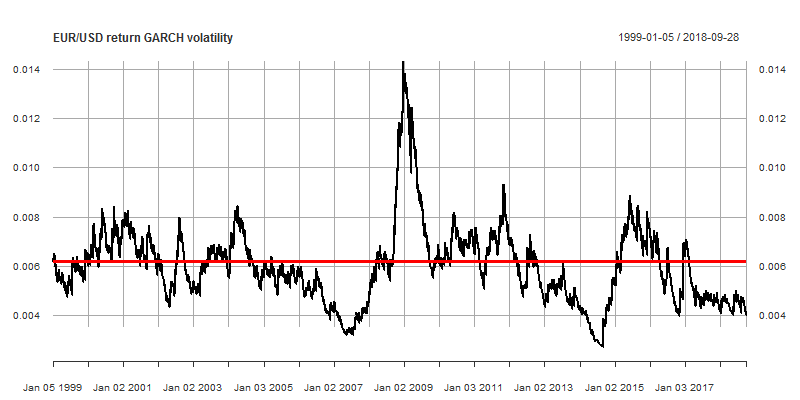Avoid unnecessary complexity
GARCH Models in R

Kris Boudt
Professor of finance and econometrics
Avoid unneeded complexity
- If you know
- The mean dynamics are negligible
- There is no leverage effect in the variance
- The distribution is symmetric and fat-tailed
Then a constant mean, standard GARCH(1, 1) with student t distribution is an appropriate specification to use:
garchspec <- ugarchspec(mean.model = list(armaOrder = c(0, 0)),
variance.model = list(model = "sGARCH"),
distribution.model = "std")
Restrict the parameter estimates
- If you know that the parameters
- are equal to a certain value
- or, are inside an interval
- Then you should impose this in the specification using the methods
setfixed()setbounds()
Application to exchange rates
Specification and estimation
garchspec <- ugarchspec(mean.model = list(armaOrder = c(0, 0)),
variance.model = list(model = "sGARCH"),
distribution.model = "std")
garchfit <- ugarchfit(data = EURUSDret, spec = garchspec)
Estimation results
coef(garchfit)
mu omega alpha1 beta1 shape
-3.562136e-05 8.005123e-08 3.097322e-02 9.674496e-01 8.821902e+00
Example of setfixed()
- If you know
alpha1 = 0.05andshape = 6: impose those values in the estimation. - How? Use of
setfixed()method on augarchspecobject
setfixed(garchspec) <- list(alpha1 = 0.05, shape = 6)
Result
garchfit <- ugarchfit(data = EURUSDret, spec = garchspec)
coef(garchfit)
mu omega alpha1 beta1 shape
-4.142922e-05 2.061772e-07 5.000000e-02 9.489622e-01 6.000000e+00
Bounds on parameters
- The GARCH parameters can be restricted to an interval.
- Sometimes the interval of plausible values is large:
- To ensure the variance is positive, we require e.g. that all variance parameters ($\omega$, $\alpha$, $\beta$, $\gamma$) are positive.
- Sometimes the interval of plausible values is smaller:
- Likely values of $\alpha$ are in between 0.05 and 0.2
- Likely values of $\beta$ are in between 0.7 and 0.95
- Such bound constraints on the parameters can be imposed using the
setbounds()method.
Example of setbounds()
setbounds(garchspec) <- list(alpha1 = c(0.05, 0.2), beta1 = c(0.8, 0.95))
Use your intuition to avoid unneeded complexity.
Use the information you have:
- to build simple (and smart) models
- to fix parameter values or set bounds
to make the GARCH dynamics realistic:
- mean reversion of the volatility around the sample standard deviation
sd(EURUSDret) # returns a value of 0.006194049
- mean reversion of the volatility around the sample standard deviation
Volatility clusters and mean reversion of volatility

Variance targeting
- Mathematically, this means that the unconditional variance implied by the GARCH models equals the sample variance $\hat \sigma^2$.
- How? By setting the argument
variance.targeting = TRUEinvariance.modelofugarchspec():
garchspec <- ugarchspec(mean.model = list(armaOrder = c(0,0)),
variance.model = list(model = "sGARCH",
variance.targeting = TRUE),
distribution.model = "std")
garchfit <- ugarchfit(data = EURUSDret, spec = garchspec)
all.equal(uncvariance(garchfit), sd(EURUSDret) ^ 2, tol = 1e-4)
TRUE
Let's impose restrictions on the GARCH model
GARCH Models in R

